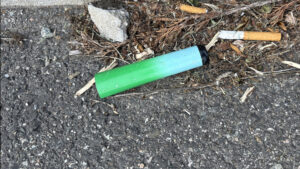
An electronic cigarette and cigarette butts littered on the side of the road. (Photo by Raeanne Raccagno)
This story was produced in collaboration with CivicStory as part of the NJ Ecology-Civics Reporting Project.
Having warm weather and seeing bright, colorful specks in the grass is usually a tell-tale sign of new flowers blooming. However, now with electronic cigarette usage on the rise and modifications for new devices being made, multicolored flecks are becoming a reflection of the increase in e-cigarette litter.
Unlike other types of litter, e-cigarette devices are not something you can simply pick up and throw away or recycle to help mitigate the problem, because the lack of a single uniform practice for disposing of the devices is currently a national issue.
“They became more non-environmentally friendly; they have tons of plastics and metals,” Carlo Favretto Jr. told The Signal about the evolution of nicotine e-cigarettes. Favretto is the statewide youth coordinator for New Jersey Prevention Network and also works with Incorruptible.Us. “The liquid inside the product, whether or not it’s disposable, does contain toxic chemicals. That’s toxic to your waterways, your soil.”
Incorruptible.Us is a New Jersey tobacco youth action group with four quarterly focus areas: social justice and taking down big tobacco, environmental tobacco issues, cessation and The Great American Smokeout and mental health and wellness. All 21 counties in New Jersey have a youth chapter, and the groups help advocate against the environmental harm vaping poses and the lack of a proper recycling protocol.
The organization is a part of Tobacco Free for a Healthy New Jersey, a program through the New Jersey Department of Health. Incorruptible.Us is funded by the New Jersey tobacco tax, which allows all their resources to be free for the public.
Data from the National Youth Tobacco Survey, released in October 2024, showed a decline in middle and high school student e-cigarette usage compared to 2023, from 2.13 million to 1.63 million students. Nonetheless, a news article by News 12 New Jersey reported that New Jersey has the sixth-highest rate of youth vaping at 25.4%.
Travis, a rising business college senior in New Jersey, who was only comfortable sharing his first name, has been vaping for eight years and said, “Not enough,” when describing his e-cigarette shopping habits.
A 2024 Truth Initiative study found that 52.9% of 1,313 U.S. residents aged 15-24 who reported using e-cigarettes discarded their empty e-cigarettes into trash receptacles.
“I open my trash can and throw it in there,” Travis said. “I don’t litter any type of trash, but I have swarms of them [e-cigarettes] in my car.”
According to Earth Day, cigarette butts have been the biggest contributor to land and ocean waste since the 1980s. In 2007, when e-cigarettes became widely available in the U.S., the devices joined their distant tobacco relatives in polluting ecosystems.
When e-cigarettes first entered the market, environmental concerns were not as popular, Favretto said. Over the past decade, e-cigarettes have become more popular and so have fights for the environment. The correlation of the two has helped lead the way for campaigning against vaping’s dangerous environmental effects.
Favretto said that from an environmental perspective, the main problem with e-cigarettes is the disposal process. Disposing of e-cigarettes in recycling or trash containers creates a danger to waste facilities due to the chemical composition of the e-cigarette’s liquids and the lithium-ion batteries.
While the EPA has information on how to safely dispose of e-cigarettes by bringing them to your local hazardous waste facility. While the website says that many towns and counties have collection for hazardous waste, Favretto said, “even your environmentally friendly waste management companies don’t necessarily have a plan to deal with that.”
“I would never tell somebody to go ahead and start collecting vape products and then bringing them to a hazardous waste facility, cause the reality is their hazardous waste facility might not take them,” Favretto said. “It’s [e-cigarettes] actually just taking up tons of room in the landfill, and now you’ve exposed that to a more toxic waste environment.”
Most waste management facilities require the lithium-ion batteries inside e-cigarettes, which are extremely flammable, to be removed and the devices are at risk of combusting, according to Favretto. Some facilities may also require that the liquid inside the vapes be removed.
“Nobody has time for that,” Travis said when he learned that some counties recommend taking the e-cigarettes to your local toxic waste facility.
The issue of e-cigarette disposal is on New Jersey’s radar. On March 17, 2025, the bill S4271, “Electronic Cigarette Extended Producer Responsibility Act,” was introduced into the New Jersey Senate to address the end-of-life problems with vape devices. The bill has a five-year timeline.
The bill addressed that despite the small size of e-cigarettes, the devices are becoming more of an issue since they are discarded more frequently than other electronic devices. The legislature would put the disposable responsibility process in the hands of the producer and form a “producer responsibility organization and to develop and implement a program to collect, reuse, recycle, transport, and soundly dispose of discarded e-cigarettes.”
Favretto said that resources and information regarding the negative impacts of vaping are available, but most public service announcements will push out facts that only highlight the personal health effects the devices have. New Jersey youth ages 13-18 who are a part of Incorruptible.Us spend a whole quarter creating campaigns on the environmental impacts of vaping, which helps give others another motivator to quit the habit.
Favretto also said the best way to implement change surrounding vaping’s effects on the environment and to help remedy the consequences seen in communities is to push for policy change.
Along with the youth group’s quarterly topics, they also do public education with their “Don’t Get Vapes In” presentation and assist or hold awareness events.
“They want to talk about these different issues around vaping that affect them in real time,” Favretto said. “I feel like a lot of our youth are environmentalists, they care about our environment, wanting to protect our planet. And they really dislike it when they’re walking outside and they see vapes discarded on the ground.”
This story was produced in collaboration with CivicStory as part of the NJ Ecology-Civics Reporting Project.
Co-published with The Signal.

Raeanne Raccagno is a CivicStory 2025 Ecology-Civics fellow and is a journalism and environmental studies major at TCNJ, where she’s the News Editor of The Signal.
